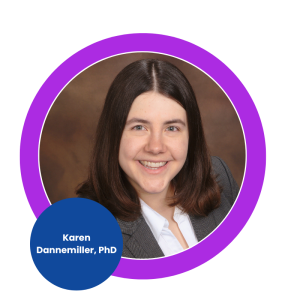Committee Members
Key Persons

President
Karen C. Dannemiller directs the Indoor Environmental Quality research group, which addresses emerging environmental concerns within the built environment. She is an associate professor at The Ohio State University with a joint appointment in Civil, Environmental & Geodetic Engineering and Environmental Health Sciences. She is also a core faculty member of the Sustainability Institute and has a courtesy appointment in Microbiology. Her work aims to improve understanding of chemical and microbial processes indoors that impact health while fostering student engagement. Funding sources include NSF, NIH, NASA, HUD, Alfred P. Sloan Foundation, and SOCHE/AFRL. Recent awards include National Science Foundation (NSF) CAREER Award, Buckeye Engineering Women in Executive Leadership (BEWEL) Leadership in Innovation Award, the Lumley Engineering Research Award, and selection in American Academy of Environmental Engineers and Scientists’ 2022 40 under 40.

Vice President, Conference Planning
Richard Shaughnessy has served as Director of the University of Tulsa’s Indoor Air Quality Research Program (TUIAP) in the Chemical Engineering Department since 1987. His studies have focused on particulate research, air cleaner evaluation, indoor chemistry, school studies, asthma/housing research, and resolution and remediation of bioaerosol-related problems. He is experienced in field research in homes and schools, and associated measurements/tools related to characterization of IAQ and moisture. He is currently furthering research studying associations between IAQ parameters in classrooms and student health/performance and is actively working toward defining a basis for “clean” in schools which applies to both performance and health of students. In addition, he currently is overseeing a HUD grant to define what constitutes “normal” background fungal ecology in homes. He was a primary member of the ACGIH Bioaerosols Committee and contributing author to the 1999 ACGIH book on Bioaerosols: Assessment and Control and contributing author and section editor to the AIHA document on Recognition, Evaluation, and Control of Indoor Mold. He has also served as President of The International Society of Indoor Air Quality and Climate (ISIAQ) and continues to work with the Society to translate science into practice.

Vice President, Technical Program Director
Dr. Elliott Gall is an associate professor at Portland State University (PSU) in the department of Mechanical and Materials Engineering. He received his B.S.E. in Environmental Engineering from the University of Florida and his Ph.D. in Civil Engineering from the University of Texas at Austin. At PSU, Dr. Gall leads the Healthy Buildings Research Laboratory (www.pdx.edu/healthy-buildings), where he and his research team conduct fundamental and applied research exploring the many factors that impact our exposure to air pollution inside buildings. Current research areas include characterizing indoor sources of volatile organic compounds, developing mitigation methods for reducing air pollution exposures during wildfires, and evaluation of air cleaning technologies. Dr. Gall has authored over 40 peer-reviewed journal publications on indoor and urban air pollution. He was acknowledged with the 2018 Yaglou Award from the International Society for Indoor Air Quality and Climate for his work on indoor ozone chemistry. His research at Portland State has been featured in national and local media, including The Atlantic, National Geographic, and The Seattle Times. He occasionally tweets about research and other topics @etgall.
Indoor Air Institute



Seema Bhangar, PhD, is Principal for Healthy Buildings and Communities at the US Green Building Council. She previously held program manager and technical lead roles at the commercial real estate firm WeWork and an environmental sensing technology startup, Aclima. She serves on a National Academies expert committee and the board of an independent nonprofit, the Indoor Air Institute. Seema was a postdoctoral research fellow at U.C. Berkeley, where she also completed a Ph.D. in environmental engineering and an M.S. in public health. She holds a B.A.S. from Stanford University.
Glenn Morrison is a professor of Environmental Science & Engineering at the University of North Carolina and has been studying indoor and outdoor air pollution and human exposure for 30 years. He received his PhD from Berkeley and his research has primarily been related to indoor physics and chemistry. He has a particular expertise in interfacial chemistry, having also worked as a chemical engineer on heterogeneous catalysis. This research has included ozone-surface chemistry, acid-base chemistry and its role in sorption to indoor surfaces, methamphetamine contamination in buildings, aerosol-SVOC modeling and field measurements of reactive oxygen species in homes. In recent years, he has focused on the role of clothing on indoor chemistry and occupant exposure. From 2014-2016 he was the President of the International Society of Indoor Air Quality and Climate (ISIAQ).
Brett Singer is the Department Head of Sustainable Energy and Environmental Systems and co-leads the Indoor Environment Group at Lawrence Berkeley National Laboratory. He earned his Ph.D. at the University of California at Berkeley in 1998. He has researched and published on outdoor and indoor air pollutant sources; physical and chemical processes that impact transport, transformation, fate and exposure; the use of building systems to control air pollutant exposures; and the impacts of controls and exposures to well being. Over the past thirteen years, he has focused on indoor air quality in homes that are built or are being retrofitted to achieve high levels of air tightness for energy efficiency. He has served on the Editorial Board of Indoor Air since 2008, served on the International Scientific Committees for ISIAQ conferences and served on the Planning Committee of the Healthy Homes Track of the National Home Performance Conference 2016-2022.
Additional Primary Organizing Committee Personnel
- Mark Hernandez, PhD: Summer School Representative
- Jordan Zambrana, PhD: Audio, Visual, and Technical Area Lead
- John Downey: Industry Liason
- Andrew Hoisington, PhD: Early Career Event Director
- Sarah Haig, PhD: Mentoring and Networking Lunch Director
- Irvan Luhung: Remote Track Coordinator
- Pawal Misztal: Remote Track Coordinator
- Alauren Lane: Marketing and Communications Intern
- Jemima E. Ohwobete: Student Helper
- Neeraja Balasubrahmaniam: Student Helper
- Jonathan King: Student Helper
- Nicholas Nastasi: Student Helper
- John Van Dusen: Student Helper
- Brett Stinson: Student Helper
- Zachary Golden: Student Helper
- Ryan Bixler: Student Helper
- Rileigh Robertson: Student Helper
Technical Program Committee Chairs
Health Outcomes Track
Gabriel Beko
Jim Zhang
Air Cleaning Track
Parham Azimi
Donghyun Rim
Ventilation and HVAC Track
Marwa Zaatari
Dusan Licina
Sensors and Monitoring Track
Jordan Clark
Alexandra Schieweck
Dampness, Mold, and the Indoor Microbiome Track
Bridget Hegarty
Sarah Haines
Naomichi Yamamoto
COVID-19 and Viral Transmission Track
Qian Hua
Shelly Miller
Thermal Comfort and Perception Track
Pawel Wargocki
Thomas Parkinson
Indoor Chemistry, Sources and Transformations Track
Yingjun Liu
Coralie Schoemaecker
Nicola Carslaw
Indoor Air, Policy, Regulation, and Standards Track
Paula Olsiewski
Tunga Salthammer
Building Simulation, Sustainability, and Energy Track
Adrian Chong
Parichehr Salimifard
Climate Change and Urbanization Track
Ellison Carter
Pawel Misztal
Aerosols/Particulate Matter
Anita Avery
Bin Zhao
